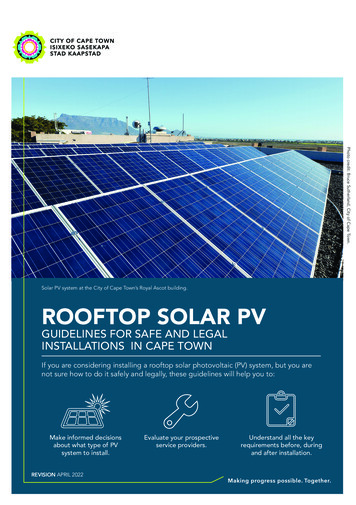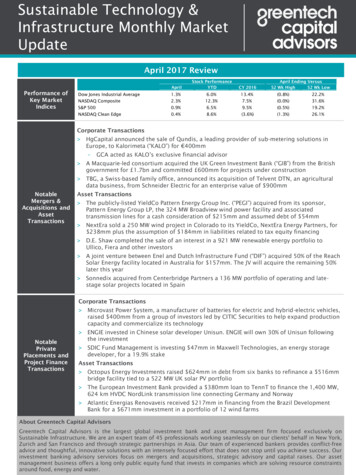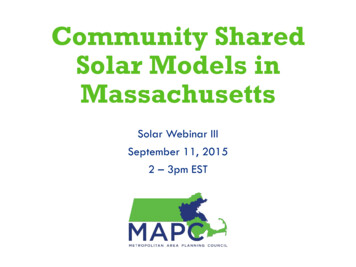
Transcription
Photo credit: Bruce Sutherland, City of Cape Town.Solar PV system at the City of Cape Town’s Royal Ascot building.ROOFTOP SOLAR PVGUIDELINES FOR SAFE AND LEGALINSTALLATIONS IN CAPE TOWNIf you are considering installing a rooftop solar photovoltaic (PV) system, but you arenot sure how to do it safely and legally, these guidelines will help you to:Make informed decisionsabout what type of PVsystem to install.REVISION APRIL 2022Evaluate your prospectiveservice providers.Understand all the keyrequirements before, duringand after installation.
The City of Cape Town is encouraging the installationof private Small Scale Embedded Generation (SSEG)systems, particularly rooftop solar PV systems.This document provides important information forinstalling a safe and legal solar PV system. or more information about the SSEG application process in the City of Cape Town’sFlicensed supply areas, go to http://www.capetown.gov.za/solarPV and http://www.capetown.gov.za/elecserviceforms For information about electricity saving, solar PV and FAQs,go to http://www.savingelectricity.org.zaCONNECTING WITHOUT APPROVAL ISILLEGAL AND DANGEROUSIllegally connected systems could compromise the safetyof your family, our family and the electricity grid.All new and existing PV systems mustbe authorised by the City of Cape TownGo to www.capetown.gov.za/solarPV to find out how to register your systemTHINGS TO CONSIDER:1. SAFETYPoorly installed and illegally connected solar PV systems are a safetyconcern: Thehousehold may be exposed to the risk of electrical firesand electric shock The safety and the power quality of the electricity grid may becompromised by connections that use the wrong equipmentor by adding unplanned generation capacity to a part of thenetwork not designed to carry it. The safety of electricity staff working on the reticulationnetwork could be compromised by electricity feeding into thegrid from the illegally connected solar PV installations.The compulsory wiring standards forgeneral electrical installations includesrequirements for solar PV installationshowever the additional wiringstandards for SSEG connected inparallel to the normal electrical supplyare still to be published.This does not mean that you are notallowed to install a PV system. Butwithout these quality reference points,you need to know how to ensure a safeinstallation and a good quality productthat complies with the law.This brochure focuses on SSEG systemswith a generation capacity smaller than1MVA however the authorisation processis the same for embedded generation(EG) installations with a generationcapacity of more than 1 MVA and lessthan 100MVA. These system sizes do notrequire a licence from NERSA.For EG systems, larger than 1MVA, theCity of Cape Town should be contacteddirectly for additional authorisationrequirements
2. TYPES OF PV SYSTEMSTHERE ARE FOUR TYPICAL CONFIGURATIONS FOR RESIDENTIAL AND COMMERCIAL PV SYSTEMS:The most common installation types are options A and B: Grid-tied feed-in and grid-tied hybrid systemsA. G RID-TIED PV SYSTEMSGrid-tied PV systemsSSEG that is connected in parallel to thedistribution network either directly or througha customer’s internal wiring is said to begrid-tied. SSEG that is connected to the gridthrough a reverse power flow blocking relayis also considered to be grid-tied.a) Grid-tied with exportCustomer is allowed to exportexcess electricity generatedby the system onto the gridbut needs to remain a NetConsumer.Solar panels convert sunlightinto clean DC energyCity of Cape Townelectricity gridExisting electricaldistribution boardCity-approvedinverter convertsDC electricity intouseable AC electriciyb) Grid-tied with no export:Customer needs toinstall reverse power flowblocking protection in order toensure that no excess electricity isexported to the grid.New City-approvedbi-directionalelectricity meterB. GRID-TIED HYBRIDPV SYSTEMSDuring peak consumptionperiods and at night, electricityis imported from the gridGrid-tied hybrid PV systems areable to disconnect the incomingsupply and connect the loadto the PV system or storedenergy in batteries. Thesesystems can operateCity of Cape Townin load-sheddingelectricity gridscenarios.Exported electricity:When the solar system generates moreelectricity than your building uses theexcess electricity goes back into the gridand the City will credit you for it at a setfeed in tariff. Grid-tied with no export:A reverse flow blocking device isincluded and no electricity is exportedback onto the grid.Solar panels convert sunlightinto clean DC energyExisting electricaldistribution boardSuitablyinterlockedchange-over switchCity-approvedinverter convertsDC electricity intouseable AC electriciyBattery is chargedwhen solarproduction isgreater thanhousehold demandNew City-approved bi-directionalelectricity meterDuring peak consumptionperiods and at night, electricityis imported from the gridExported electricity:When the solar system generates more electricity thanyour building uses the excess electricity goes back intothe grid and the City will credit you for it at a set feedin tariff.
C. S TANDBY PV SYSTEMS (INTERCONNECTED WITHELECTRICAL INSTALLATION)In a standby PV system, electrical loads aresupplied by either the PV system or the gridbut never both at the same time. Thereare two types of standby PV systems:1) Passive standby UPS utilisedas standby hybrid SSEG, and 2)Alternative supplySolar panels convert sunlightinto clean DC energyExisting electricaldistribution boardSuitablyinterlockedchange-over switchCity of Cape Townelectricity gridCity-approvedinverter convertsDC electricity intouseable AC electriciyBattery is chargedwhen solarproduction isgreater thanhousehold demandNew City-approved bi-directionalelectricity meterDuring peak consumptionperiods and at night, electricityis imported from the gridExported electricity:When the solar system generates more electricity thanyour building uses the excess electricity goes back intothe grid and the City will credit you for it at a set feedin tariff.D. O FF-GRID (STANDALONE) PV SYSTEMSStandalone or off grid PVsystems A PV system that is wiredcompletely separately fromthe electricity grid: cannot beNo change to existingconnected directly or indirectlydistribution boardthrough the building’sExisting electricitymeterwiring. Typically wired forspecific loads only. ThisElectricity gridcould include a geyserelectrical heating elementsupplied from a solarPV generation sourcedirectly.Solar panels convert sunlightinto clean DC energyCharge controllerPV systemdistribution boardBattery bankInverter convertsDC electricityinto usable ACelectricityElectricity circuitindependent ofthe electricity grid
CCTESKOMThe City distributes electricity to 75% ofCape Town, while Eskom distributeselectricity directly to the remaining 25%.Make sure you know who distributes electricity to your area: it will beon your electricity bill.The type of PV systems that are permitted to be connected to the networkmay differ between City and Eskom supply areas. Furthermore the processof authorisation will be different.For more information on the application processes: City of Cape TownCustomers: https://www.capetown.gov.za/solarPV for options and andhttp://www.capetown.gov.za/elecserviceforms for application forms anddocuments.Eskom customers: bedded-generators/NOTE:If your property is in the City’s licensed area of supply, you will require written permission from the City’sElectricity Generation and Distribution Department prior to installing your system, irrespective of the typeof system. If you install a grid-tied system without the City’s permission, you are doing so illegally. To gridtie and feed-in, you will require a specialised meter and you will be placed on a new tariff. To grid tie withreverse power flow blocking, you must have a prepayment meter and will remain on your existing tariff.For details on how to grid tie and register your grid-tied or offgrid system for authorisation, consult theCity’s Requirements for Small Scale Embedded Generation at:www.capetown.gov.za/ElecServiceForms, under ‘Document downloads’.Off-grid (Standalone) solar PV installations must also follow the application process and you will have toverify that the system is in fact off-grid.Grid-tied hybrid PV installations must make use of an external automatic change-over switch betweengrid supply and storage supply. For more details on the specifications, consult the City’s RequirementsDocument for Small-Scale Embedded Generation.SSEG customers are required to be net consumers and import (purchase) more electricity than theyexport (feed-in to the network) over a rolling 12-month period, however the City is currently investigatingrelaxing this restriction.Photo credit: Bruce Sutherland, City of Cape Town.Grid-tied PV system at Black River Park.
3. CHECKLISTS FOR SAFE AND LEGALROOFTOP SOLAR PV INSTALLATIONS3.1. ENSURING A QUALITY INSTALLATION SERVICEThere are many PV service providers currently operating in Cape Town. This checklistmay assist you with reducing the risk of a poor or illegal installation. BUSINESS PERFORMANCE Verify if the PV service provider has substantial priorexperience in PV installations and ask for referenceswith contact details. Establish whether the PVservice provider designed, supplied and installedthe systems or only carried out one or two of thesesteps. It is recommended that the PV service provider isan accredited service provider under a third partyquality assurance programme such as:- PV Green Card: A South African PhotovoltaicIndustry Association (SAPVIA) endorsedprogramme to ensure the quality and safety of PVinstallations. www.pvgreencard.co.za- P4 Platform quality assurance program: Anindependent system that scores contractors onperformance, knowledge and best practice topromote good practice in the PV ram Also request to see proof of electrical Certificatesof Compliance (CoCs) and/or professional engineersign offs of previous installations. Ask for proof ofprevious installations that have been authorised bythe City of Cape Town. STAFF QUALIFICATIONS ARE VERY IMPORTANT Find out if the PV service provider employs orsubcontracts qualified staff to design andinstall systems. Your installation may not exceed1000 volts DC in terms of NRS 097-2-1: 2017 Ed2.1.The system’s design and installation can be doneby a person deemed competent as an electricalcontractor by the Department of Labour andEmployment (DoLE). Ask for proof of registration(also called a wireman’s licence and DoLEregistration), and check that it is up-to-date.This registration is critical because it means that: - the electrician is proficient in the national wiringcode SANS 10142-1 latest publication (currently2021 Ed 3.1)’, and can install your PV systemsafely.- the electrician is permitted to issue a CoC for theinstallation, which will confirm that the installationhas been performed in compliance with thenational wiring codes. If you are planning to install a grid-tied system,the City also requires that your grid-tied systemis signed off by an Engineering Council of SouthAfrica (ECSA) registered professional. Check thatthe PV service provider has such a person available. REGISTRATION WITH SAPVIA AND WITH THEELECTRICAL CONTRACTORS BOARD (ECB) Find out if your PV service provider is a member ofSAPVIA and the ECB. Although SAPVIA and ECBmembership is not compulsory, it should be a goodindication how committed the service provider istowards keeping abreast of industry best practiceand complying with legislative requirements andstandards in the PV and broader electrical sectors.
3.2. BEFORE APPROVING THE DESIGN AND PURCHASING A SYSTEMOnce you are satisfied that your PV service provider has the skills and experience toperform the work, you may go ahead with planning the installation. Here are the key pointsto follow at this stage: EFORE INSTALLING A PV SYSTEM, BECOMEBMORE ELECTRICITY-EFFICIENT Before installing a PV system, it makes economicsense to become more electricity-efficient. By doingso, you will reduce the size and cost of the PV systemyou need. Consider installing an efficient water heater(solar water heater or heat pump), installing efficientlighting and switching to gas for cooking and heating.For tips go to www.savingelectricity.org.za. OBTAIN APPROVAL FROM THE CITY Regardless of the type of solar PV system you areinstalling, you need to obtain authorisation in writingfrom the City prior to installation. You will find all thenecessary documentation atwww.capetown.gov.za/SolarPV, under ‘Registeryour solar PV system’. ll generation facilities and equipment must beAregistered with the City. OBTAIN A STRUCTURAL ASSESSMENT Generally roofs can withstand the weight and windload of PV panels. However, it is advisable to obtaina structural assessment of the roof to determinewhether it can withstand these loads. Structuralengineers can provide this service.NO NEED TO SUBMIT BUILDING PLANS There is no need to submit building plans to the Cityfor PV systems - unless the panels protrude morethan 600 mm above the highest point of the roof, orthey are raised more than 1.5 m above any point onthe roof, or if ground mounted, the panels in theirinstalled position project more than 2,1 metres abovethe natural/finished ground level.BUY THE CORRECT INVERTER If you are planning to install a grid-tied system,ensure that you are using an inverter approvedby the City. You can find the list of approvedinverters at www.capetown.gov.za/SolarPV under’Document Downloads’.CHECK PV PANEL STANDARDS At the very least, ensure that the PV panels youwill use have a Certificate of Compliance with theSANS/ IEC standards:SANS/IEC 61215: 2015 Crystalline siliconterrestrial PV modules.SANS/IEC 61646: 2016 - Thin film terrestrial PVmodulesIEC standards are the international version of theSABS, and are a good indication of panel quality.Ask your service provider for proof.STORE BATTERIES SAFELY If you are installing batteries, make sure that theyare stored in a properly racked, well ventilated, dryroom, in accordance with the Occupational Healthand Safety (OHS) Act, Act 85 of 1993.3.3. DURING INSTALLATIONDON’T INSTALL WITHOUT AUTHORISATION All rooftop solar PV systems require permission inwriting from the City prior to installation. ENSURE EFFECTIVE CONTROL Ensure that the electrician who will be signing off theelectrical CoC is in control on site and carries out orsupervises the work effectively.CHECK PLACEMENT ON THE ROOF Ask the PV installer to demonstrate that theplacement of the panels on the roof allowsadequately for cleaning and also provides access forthe Fire Department. ENSURE SPECIALISED DC CIRCUIT BREAKERSARE BEING USED DC current from your PV panels requires specialisedcircuit breakers. Ensure that your service provider isusing these.MANAGE HEALTH AND SAFETY ON SITE Ensure installers work according to national healthand safety codes, and hold Working at Heighttraining certificates. If working at heights above3m, they must use some form of fall arrest system.Personal protection equipment (hard hats etc.)must be used at all times.
3.4. POST-INSTALLATION REQUEST AN ORIGINAL ELECTRICALCERTIFICATE OF COMPLIANCE (CoC) he Department of Labour and EmploymentTregistered installation electrician who performs theinstallation must supply you with a CoC after s/hehas carried out the installation and completed therequired tests and checks. All PV systems installedin the City of Cape Town grid must be certified.Commercial and industrial installations must becertified by an ECSA-registered professionalengineer, certified engineer or technologist.Residential installations may be certified as above orby ECSA-registered professional technician.Remember that as the property owner, you areresponsible for the safety of the electrical installationon your property in terms of the OHS Act. Without avalid electrical CoC, you will find it difficult to provethat you have taken reasonable precautions shouldanything go wrong. Insurance companies might notpay out for damages; and if someone is injured ordies as a result of the installation, you could be heldliable as the property owner.If the PV installation is off-grid and the voltageis higher than 50V, the Department of Labourand Employment also requires a CoC for theinstallations.REQUEST QUALITY ASSURANCE CERTIFICATES Obtain a quality assurance certificate such as aPV GreenCard. These documents include importantinformation on the equipment used and technicaldetails of the installation which will be useful forfuture reference.CHECK FOR ROOF LEAKS Check the installation work has not caused leaks inyour roof.WARRANTIES AND MANUALS Obtain all warranties and guarantees on offer,both for the installation as a whole and for itscomponents (solar modules, inverters, structuralsystem). Warranties should be for a minimum of 1year, preferably 5 years. Solar PV panels themselvestypically have much longer warranties. Also, checkyou have all operations and maintenance manuals.RECOURSE FOR POOR WORK If you are not satisfied with the work, request anindependent inspection of the installation.In Cape Town, an organisation that carries out thiswork is the Electrical Approved Inspection Authorityof Southern Africa (EAIASA). Before it can carry outan inspection, you must have the original CoC andyou will need to pay an inspection fee.Photo credit: Bruce Sutherland, City of Cape Town.Grid-tied PV system at Bayside Mall.Produced by the City of Cape Town Energy DirectoratePlease note that this document may be updated from time to time, so visit these websites to check for the most recent version:www.capetown.gov.za/SolarPV and/or www.SavingElectricity.org.za.
The most common installation types are options A and B: Grid-tied feed-in and grid-tied hybrid systems B. GRID-TIED HYBRID PV SYSTEMS City of Cape Town electricity grid Solar panels convert sunlight into clean DC energy City-approved inverter converts DC electricity into useable AC electriciy New City-approved bi-directional electricity meter











